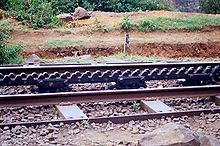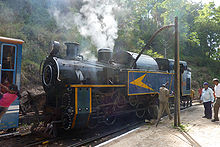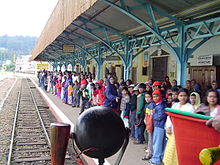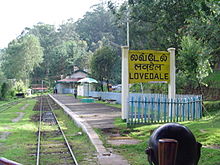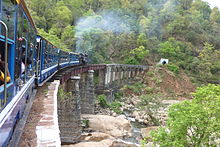- Nilgiri Mountain Railway
-
The Nilgiri Mountain Railway is a railway in Tamil Nadu, India, built by the British in 1908,[1] and was initially operated by the Madras Railway Company. The railway still relies on its fleet of steam locomotives.[2] NMR comes under the jurisdiction of the newly formed Salem Division. In July 2005, UNESCO added the Nilgiri Mountain Railway as an extension to the World Heritage Site of Darjeeling Himalayan Railway, the site then became known as "Mountain Railways of India."[3] after it satisfied the necessary criteria, thus forcing abandonment of the modernisation plans. For the past several years diesel locomotives have taken over from steam on the section between Coonoor and Udhagamandalam. Local people and tourists have led a demand for steam locos to once again haul this section.[2] The famous Hindi song "Chaiyya Chaiyya" from the film "Dil Se" featuring Shahrukh Khan was shot on the roof top of NMR.[citation needed]
Contents
Operation
 Functioning of the rack and pinion.
Functioning of the rack and pinion.
The NMR track is 1,000 mm (3 ft 3 3⁄8 in) gauge and the railway is isolated from other metre gauge lines.
Between Mettupalayam and Coonoor, the line uses the Abt rack and pinion system to climb the steep gradient. On this rack section trains are operated by 'X' Class steam rack locomotives manufactured by the Swiss Locomotive and Machine Works of Winterthur in Switzerland. These steam locomotives can be used on any part of the line (either with or without the rack section),but the newer diesel locomotives can operate on the entire section, between Mettupalayam and Udagamandalam.This signals the beginning of the process to phase out the coal-fired vintage Swiss engines that took scores of passengers on the rack and pinion track to Coonoor and Udhagamandalam, covering 41.8 km, 108 curves, 16 tunnels and 250 bridges
Hence, the Southern Railway decided to replace the coal-fired locomotives. The work was entrusted to Golden Rock Workshop of Southern Railway at Tiruchirapalli. Each of the new engines weighs a little over 50 tonnes and cost Rs.10 crore.
The new engine has been provided with pilot and primary burners with separate tanks to hold about 850 litres of diesel and 2,250 litres of furnace oil. The hauling capacity of this new engine is 97.6 tonnes and it can run at a speed of 30 km an hour in plains and at 15 km an hour on a gradient.
Officials hoped to put the engine to use by Sunday on the Mettuppalayam–Coonoor section. The arrival of the new engines raises hopes of eliminating the disruption in service that occurred frequently over the last two years.
For long, the X Class locomotives manufactured by Swiss Locomotive and Machine Works of Winterthur in Switzerland lent that distinct charm to NMR. These locomotives are six to eight decades old, railway officials said
The steam locomotives are always marshalled at the downhill (Mettupalayam) end of the train. The average gradient in this rack section is 1 in 24.5 (4.08%), with a maximum of 1 in 12 (8.33%). Between Coonoor and Udagamandalam the train is operated by a YDM4 diesel locomotive using conventional rail adhesion principles. On this section the locomotive is always at the Coonoor end of the train as although the line is not steep enough to need a rack rail, the ruling gradient out of Coonoor is still very steep at 1 in 25 (4%).
As of 2007, there is one train a day over the rack section, which starts from Mettupalayam at 07:10 and reaches Ooty at noon. The return train starts from Ooty at 15:00, and reaches Mettupalayam at 18:35. The train is scheduled to connect to the Nilgiri Express, which travels from Mettupalayam to Chennai via Coimbatore. A summer special service is also run during the months of April and May, starting from Mettupalayam at 09:30 and from Ooty at 12:15. Between Coonoor and Udagamandalam, there are four daily trains each way.
Even though the NMR stations have networked computerised ticketing systems for onward journeys, it still issues Edmondson style manual tickets for the Ooty-Mettupalayam journey to preserve the 'World Heritage Site' status of the railway. However, ticket booking is similar to other conventional trains and can also be done via the Indian Railways' website.[4] It is advisable to book tickets for this railway in advance, especially during peak season.
The majority of repairs to the locomotives are carried out at the Coonoor shed but many of the steam locomotives have been rebuilt at the Golden Rock Workshops. Carriages are repaired at Mettupalayam but, like the locomotives, are taken to one of the big railway workshops for major work. Due to its popularity, a number of passengers using the NMR have requested that the Southern Railways convert the section from Coonoor to Udagamandalam to steam locomotive[citation needed], extending the present steam traction between Mettupalayam and Coonoor.
The route
Nilgiri-Mountain Railway 


0 km Mettupalayam 


8 km Kallar 


13 km Adderly 


18 km Hillgrove 


21 km Runneymede 


25 km Kateri Road 


28 km Coonoor 


29 km Wellington 


32 km Aruvankadu 


38 km Ketti 


42 km Lovedale 


46 km Ooty The 'Nilagiri Passenger' train covers a distance of 26 mi (41.8 km),[2] travels through 208 curves, 16 tunnels,[2] and 250 bridges.[2] The uphill journey takes around 290 minutes (4.8 hours), and the downhill journey takes 215 minutes (3.6 hours) It has the steepest track in Asia with a maximum gradient of 8.33%.[2]
- Mettupalayam - 0 km (0 mi), 1,069 ft (325.8 m) above sea level - Junction with the 5 ft 6 in (1,676 mm) (Indian Gauge) line from Coimbatore. Passengers cross the platform to board the Nilagiri Passenger train (NMR). There is a small locomotive shed here and also the carriage workshops for the line.
-
- Leaving Mettupalayum, the line is adhesion worked and actually drops for a short distance before crossing the Bhavani River, after which it starts to climb gently.
- Kallar - 8 km (5 mi), 1,260 ft (384 m) - Closed as a passenger station, this is where the rack rail begins. As the train leaves the station, the gradient is 1 in 12 (8.33%).
- Adderly - 13 km (8.1 mi), 2,390 ft (728.5 m) - Closed as a passenger station but is still a water stop.
- Hillgrove - 18 km (11.2 mi), 3,580 ft (1,091.2 m) - Block post and water stop, also has refreshments for passengers.
- Runneymede - 21 km (13 mi), 4,612 ft (1,405.7 m) - Closed as a passenger station but is still a water stop.
- Kateri Road - 25 km (15.5 mi), 5,070 ft (1,545.3 m) - Closed as a passenger station, trains do not stop here.
- Coonoor - 28 km (17.4 mi), 5,616 ft (1,711.8 m) - main intermediate station on the line at site of the locomotive workshops as well as the top end of the rack rail. Trains must reverse a short distance before continuing their climb to Ooty. It is normal for the locomotive to be changed here with diesel traction, being normal for all trains to Ooty.
- Wellington - 29 km (18 mi), 5,804 ft (1,769.1 m)
- Aruvankadu - 32 km (19.9 mi), 6,144 ft (1,872.7 m)
- Ketti - 38 km (23.6 mi), 6,864 ft (2,092.1 m)
- Lovedale - 42 km (26.1 mi), 7,694 ft (2,345.1 m)
-
- From a short distance before Lovedale, the line descends into Ooty.
- Ooty - 46 km (28.6 mi), 7,228 ft (2,203.1 m).).
Other tourist trains in India
- Palace on Wheels
- Royal Rajasthan on Wheels
- The Golden Chariot
- Deccan Odyssey
- Darjeeling Himalayan Railway
- Kalka-Shimla Railway
- Kangra Valley Railway
- Matheran Hill Railway
- Fairy Queen
- India on Wheels
- The Indian Maharaja
Television film
In the UK, the BBC made a series of three documentaries[5] dealing with Indian Hill Railways, with the NMR being featured in the second programme shown in February 2010. (The first film covers the Darjeeling-Himalayan Railway and the third the Kalka-Shimla Railway.) The films were directed by Tarun Bhartiya, Hugo Smith and Nick Mattingly, and produced by Gerry Troyna. The series won the UK Royal Television Society Award in June 2010.[6]
Coonoor station was one of two used as locations in David Lean's film A Passage to India [1]. Ketti station was used as the location in a malayalam film Summer in Bethlehem
See also
References
- ^ "Mountain Railways of India". UNESCO. http://whc.unesco.org/en/list/944/. Retrieved 1 March 2010.
- ^ a b c d e f (in English) Indian Hill Railways: The Nilgiri Mountain Railway (TV). BBC. 21 February 2010. http://www.bbc.co.uk/programmes/b00qzzlm. Retrieved 1 March 2010.
- ^ NMR added as a World Heritage Site
- ^ Ticket booking
- ^ "Indian Hill Railways". BBC. http://www.bbc.co.uk/programmes/b00qzzlm#synopsis. Retrieved 28 February 2010.
- ^ "Documentary on Hill railways of India bags UK award". Express India. http://www.expressindia.com/latest-news/documentary-on-hill-railways-of-india-bags-uk-award/636391/. Retrieved 19 September 2010.
External links
- NMR (Nilgiri Mountain Railway) - From Lifeline to Oblivion
- A photo journey that will take you back in time
- Indian railways site on the NMR
- Railmuseum/kk
- Images and info
- Toy train chugs on
- Ooty train Photographs
- 20 photos between Ooty and Coonoor
- The toy train chugs on
- International Working Steam [2]
World Heritage Sites in India North Agra Fort · Buddhist Monuments at Sanchi · Fatehpur Sikri · Humayun's Tomb · Keoladeo National Park · Khajuraho Group of Monuments · Mountain Railways of India (Kalka-Shimla Railway)1 · Nanda Devi and Valley of Flowers National Parks · Qutub Minar and its Monuments · The Red Fort complex · Rock Shelters of Bhimbetka · Taj Mahal
Northeast East Mahabodhi Temple Complex at Bodh Gaya · Mountain Railways of India (Darjeeling Himalayan Railway)1 · Sun Temple at Konark · Sundarbans National Park
South Great Living Chola Temples at Thanjavur, Gangaikonda Cholapuram and Darasuram · Group of Monuments at Hampi · Group of Monuments at Mahabalipuram · Group of Monuments at Pattadakal · Mountain Railways of India (Nilgiri Mountain Railway)1
West Ajanta Caves · Champaner-Pavagadh Archaeological Park · Chhatrapati Shivaji Terminus · Churches and convents of Goa · Elephanta Caves · Ellora Caves · Jantar Mantar
1 Shared with other region/sTourism in The Nilgiris Gardens and Parks  Botanical Garden Ooty · Rose Garden Ooty · Sim's Park Coonoor · Mukurthi National Park · Mudumalai National Park · Bandipur National Park · Droog Fort · Lady Canning Seat
Botanical Garden Ooty · Rose Garden Ooty · Sim's Park Coonoor · Mukurthi National Park · Mudumalai National Park · Bandipur National Park · Droog Fort · Lady Canning Seat
View Point  Doddabetta · Lamb's Rock · Dolphin's Nose · Needle hill viewpoint · Ketti Valley view · Kodanad View Point · Rangaswamy Peak and Pillar · Needle Rock View Point · Frog Hill View Point · Western Catchments
Doddabetta · Lamb's Rock · Dolphin's Nose · Needle hill viewpoint · Ketti Valley view · Kodanad View Point · Rangaswamy Peak and Pillar · Needle Rock View Point · Frog Hill View Point · Western CatchmentsLake and Water Falls  Ooty Lake · Pykara Lake · Upper Bhavani Lake · Emerald Lake · Avalanche Lake · Porthimund Lake · Pykara water falls · Kalhatti falls · Law's falls · Kateri falls · Catherine Falls · Kamaraj Sagar Dam
Ooty Lake · Pykara Lake · Upper Bhavani Lake · Emerald Lake · Avalanche Lake · Porthimund Lake · Pykara water falls · Kalhatti falls · Law's falls · Kateri falls · Catherine Falls · Kamaraj Sagar DamOther Tourist spots Nilgiri Mountain Railway · Adam's fountain · Ooty Golf Course · Stone House, Ooty · Toda huts · Ooty Racecourse · Nilgiri mountains · Ooty Radio Telescope · Gori sholaEvents  Summer Festival
Summer FestivalTourism in Tamil Nadu · Tourism in India · Ooty · Coonoor · Gudalur · Kotagiri
Categories:- Metre gauge railways in India
- Tourism in Tamil Nadu
- Railway lines opened in 1899
- Railway lines in India
- Mountain railways in India
- Ooty
- Rack railways
- Rack railways in India
- Nilgiris District
Wikimedia Foundation. 2010.

